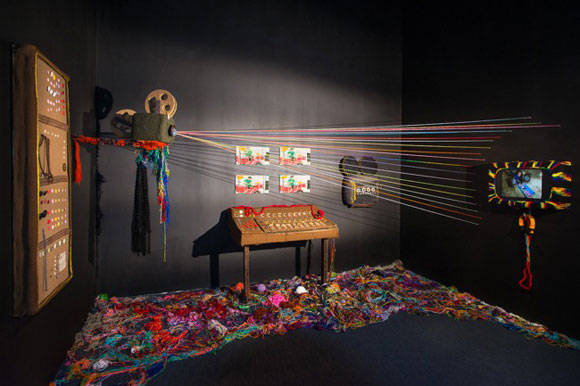

Spectacle: A Music Video Exhibition For the MTV Generation
 Currently on display at the Museum of the Moving Image in Astoria, Queens, Spectacle: The Music Video is the first ever exhibition to celebrate the artform that was once the bread and butter of MTV. Curators Jonathan Wells and Meg Grey Wells put together an impressive spread of 300 music videos in beautifully designed exhibition.
Currently on display at the Museum of the Moving Image in Astoria, Queens, Spectacle: The Music Video is the first ever exhibition to celebrate the artform that was once the bread and butter of MTV. Curators Jonathan Wells and Meg Grey Wells put together an impressive spread of 300 music videos in beautifully designed exhibition.
While most music videos in the exhibition were featured in looped groupings on wall-mounted monitors, the videos that received their own, stand-alone installations were ones that had accompanying props or assets left over from production. For example, the four jumpsuits worn in the video for OK GO’s “This Too Shall Pass” are hung on the wall next to a video monitor. Another corner is filled with a giant model of the anthropomorphic milk carton from Blur’s “Coffee and Tea.” Also on display is a prop from “Tonight, Tonight,” the Smashing Pumpkins’ homage to Georges Méliès’ “A Trip to the Moon.”

Stop motion and 2-D animation are heavily represented in the show. Piles of colorful yarn props comprise an installation for Steriogram’s “Walkie Talkie Man,” directed by Michel Gondry. As one of the most prolific and creative music video directors in the past two decades, Gondry’s work received the most gallery space by far. Another corner is accented with bold LEGO pieces while an accompanying monitor plays “Fell in Love With A Girl,” the iconic music video that pulled The White Stripes into the mainstream.
Original drawings from “Take On Me” by A-ha are on display as a reminder of the video’s landmark status in pop culture. Director Steve Barron and animation directors Michael Patterson and Candice Reckinger combined pencil-sketch animation, rotoscoping and live action for a total of 3,000 frames that took four months to complete. It is still one of the most memorable music videos of all time, and was the first to push a song to number one one the charts.

Several monitors around the gallery space display curated lumps of animated music videos, but there were a few notably absent or screened without additonal background information: Kanye’s Bakshi-inspired video for “Heartless,” Peter Gabriel’s “Sledgehammer,” and anything by The Gorillaz. Of course it’s impossible to satisfy everyone’s expectations, so the curators devised a lounge provided by Vevo where patrons can select and watch their favorite music videos.
Approaching this exhibit, I wondered how the curators, who are self-proclaimed products of the MTV generation, could keep their nostalgia in check. At times they can’t, and the exhibition is more celebratory than critical. The future of the music video isn’t wholly confronted. An installation of Arcade Fire’s ventures into interactive music videos was one of the most current explorations of the medium on display. Additionally, fan-made videos, highlighted in a section called “REMIX,” show how fans harness YouTube to interact with and create their own music videos today. But the question still remains: what will the music video of tomorrow look like?
Where the exhibition shines, however, is establishing the history of music videos, tracing their roots back to the earliest sound films of the 1920s. Included was a mention of “Colour Box” by Len Lye, a 1935 experimental animated short set to a Cuban dance beat. The narrative thread continues on, showing how The Beatles, Queen, David Bowie and several experimental artists contributed to the establishment of the music video as a definitive medium.
The exhibition, which is absolutely worth seeing, is currently on loan from Contemporary Arts Center in Cincinnati. With any hope, the show will become even more accessible and take part in a national tour. And now that Billboard has decided to include YouTube views in its rankings, the music video could once again be a driving force worth rediscovering.

.png)